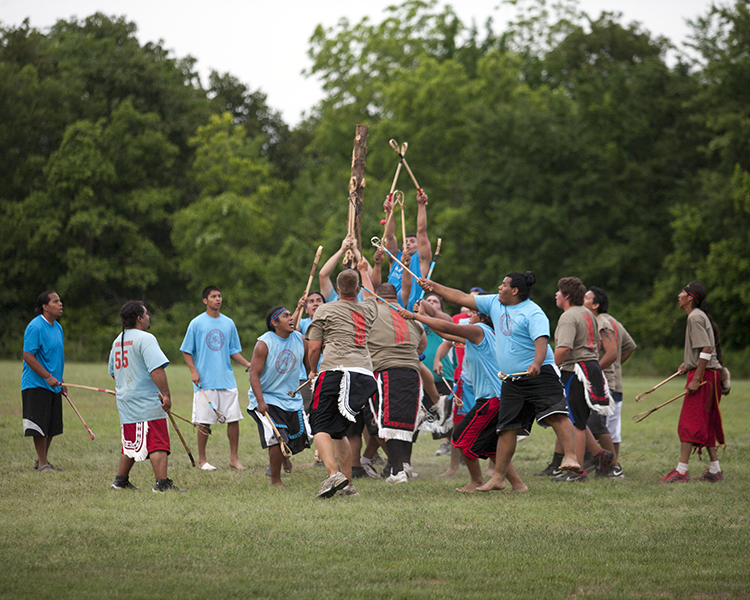In the intricate fabric of Indigenous North American cultures, stickball stands as a testament to both the physical prowess and spiritual significance embedded in traditional athletic pursuits. As we delve into the world of Indigenous North American stickball, we uncover a rich tapestry woven with history, spirituality, and the enduring spirit of community.
A Time-Honored Tradition: Origins and Historical Roots
Indigenous North American stickball traces its roots deep into the annals of history. Originating centuries ago, this athletic tradition has been practiced by various Indigenous nations, each infusing the game with its unique cultural nuances. For many, stickball is more than a sport; it is a sacred ritual, a communal expression, and a living connection to ancestral legacies.
The Game and Its Players: A Dance of Skill and Spirituality
At its essence, stickball is a team sport played with long sticks, often resembling miniature lacrosse sticks, and a small ball. The objective varies among different Indigenous communities, but common themes include scoring goals by getting the ball through designated markers. The game, often accompanied by vibrant ceremonies, becomes a dance of skill and spirituality, fostering a deep sense of unity among participants.
Spiritual Significance: Bridging the Physical and Metaphysical Realms
In Indigenous cultures, stickball transcends the physical realm, embodying spiritual dimensions. The game is frequently tied to creation stories, representing cosmic battles, the cycle of life, and the interconnectedness of all things. Playing stickball becomes a form of prayer, an offering to the spirits, and a means of maintaining harmony with the natural world.
Regional Variations: Diverse Expressions of Stickball Tradition
As diverse as the Indigenous nations themselves, stickball manifests in various regional variations. The Cherokee, Choctaw, and Seminole, among others, each bring their distinctive rules, equipment, and ceremonial practices to the game. This diversity reflects the dynamic nature of Indigenous cultures, where traditions evolve and adapt while preserving their core values.
Stickball Ceremonies: Rituals Beyond the Field
The significance of stickball extends beyond the playing field into ceremonial spaces. Stickball games are often accompanied by elaborate rituals, including songs, dances, and communal gatherings. These ceremonies serve to honor the game, its players, and the spiritual entities believed to be present during the matches.
Women in Stickball: Guardians of Tradition and Cultural Continuity
While historically male-dominated, stickball is not solely a masculine pursuit. In some Indigenous communities, women play a crucial role in the ceremonial aspects of stickball, serving as spiritual guardians and contributing to the continuity of cultural practices. Their involvement challenges stereotypes and reinforces the inclusive nature of Indigenous traditions.
Impact of Colonization: Challenges and Resilience
The history of Indigenous North American stickball is also marked by the impact of colonization. Attempts to suppress traditional practices, including stickball, were prevalent, but Indigenous communities displayed remarkable resilience. Despite challenges, stickball survived, evolving into a symbol of cultural resistance and resilience.
Revitalization Efforts: Breathing New Life into Ancient Games
In contemporary times, there has been a resurgence of interest in Indigenous North American stickball. Efforts to revitalize and preserve traditional games have gained momentum, with communities hosting stickball tournaments, educational initiatives, and cultural exchanges. These endeavors reflect a determination to reclaim cultural heritage in the face of historical adversity.
Impact on Modern Sports: Echoes of Stickball in Popular Games
The influence of Indigenous North American stickball extends beyond its cultural context. Elements of the game have found echoes in modern sports like lacrosse, a sport that shares similarities with stickball and has grown into a globally recognized athletic pursuit. This influence underscores the enduring impact of Indigenous athletic traditions on the broader sporting landscape.
Community Building: Stickball as a Catalyst for Unity
In Indigenous communities, stickball is more than a game; it is a community-building tool. Tournaments bring people together, fostering a sense of unity and camaraderie. The spirit of friendly competition blends seamlessly with the spiritual dimensions of the game, creating an atmosphere where participants and spectators alike feel connected to something greater than themselves.
Environmental Harmony: Stickball as a Reflection of Indigenous Ecological Wisdom
The deep connection to nature in Indigenous cultures is reflected in stickball. The game is often played in open spaces surrounded by the natural world, emphasizing the harmony between humans and their environment. This ecological consciousness aligns with Indigenous teachings about stewardship and respect for the Earth.
FAQs (Frequently Asked Questions)
Q: What is the historical significance of stickball in Indigenous North American cultures?
A: Stickball holds immense historical significance as a time-honored tradition practiced by various Indigenous nations. It is a cultural touchstone, embodying both physical prowess and spiritual connection to ancestral legacies.
Q: How does stickball transcend the physical realm and hold spiritual significance?
A: Stickball is more than a sport; it is a spiritual practice. It often ties to creation stories, representing cosmic battles and the interconnectedness of all things. Playing stickball becomes a form of prayer and an offering to the spirits.
Q: Are there regional variations in the way stickball is played among Indigenous communities?
A: Yes, there are diverse regional variations in stickball, with different rules, equipment, and ceremonial practices. Each Indigenous nation brings its unique cultural nuances to the game, reflecting the dynamic nature of Indigenous traditions.
Q: What role do women play in Indigenous North American stickball?
A: While historically male-dominated, women play a crucial role in stickball ceremonies in some Indigenous communities. They serve as spiritual guardians, contribute to the continuity of cultural practices, and challenge stereotypes associated with gender roles in sports.
Q: How has colonization impacted the practice of stickball among Indigenous communities?
A: Colonization had a profound impact on Indigenous North American stickball, with attempts to suppress traditional practices. Despite challenges, stickball survived as a symbol of cultural resistance and resilience against historical adversities.
Q: What efforts are being made to revitalize and preserve Indigenous North American stickball?
A: There is a resurgence of interest in stickball, with communities undertaking efforts to revitalize and preserve traditional games. This includes hosting stickball tournaments, educational initiatives, and cultural exchanges to reclaim cultural heritage.
Q: How has stickball influenced modern sports, particularly lacrosse?
A: Stickball has influenced modern sports like lacrosse, which shares similarities with Indigenous stickball. The impact of Indigenous athletic traditions is evident in the growth and recognition of lacrosse as a globally recognized sport.
Q: In what ways does stickball serve as a community-building tool in Indigenous communities?
A: Stickball is a catalyst for unity in Indigenous communities. Tournaments bring people together, fostering a sense of camaraderie and connection. The spirit of friendly competition blends seamlessly with the spiritual dimensions of the game.
Q: How does stickball reflect Indigenous ecological wisdom and a connection to nature?
A: Stickball is often played in open spaces surrounded by the natural world, emphasizing the deep connection between Indigenous cultures and their environment. This reflects Indigenous teachings about stewardship and respect for the Earth.
Q: What is the contemporary relevance of Indigenous North American stickball in the modern era?
A: In the modern era, stickball remains relevant as a cultural
Conclusion: Sustaining the Spirit of Indigenous North American Stickball
In the rhythmic cadence of stickball games, we find the heartbeat of Indigenous North American cultures, echoing through the centuries. This traditional athletic pursuit, deeply rooted in history and spirituality, transcends the confines of a mere sport. Indigenous North American stickball is a cultural symphony, weaving together threads of resilience, community, and a profound connection to the natural world.
As we traverse the landscape of stickball’s origins and historical roots, it becomes evident that this time-honored tradition is more than just a game. It is a living testament to the endurance of Indigenous communities, a tapestry woven with the stories of generations who have played on the same sacred grounds.
The dance of skill and spirituality within the game reflects a unique fusion of physical prowess and metaphysical significance. Stickball is not merely a contest of goals; it is a prayer, an offering to the spirits, and a bridge between the tangible and the transcendent. The regional variations across Indigenous nations showcase the diverse expressions of a tradition that adapts while preserving its cultural core.
In acknowledging the impact of colonization, we witness the resilience of Indigenous communities. Stickball, once suppressed, now stands tall as a symbol of cultural resistance and endurance. Efforts to revitalize and preserve this ancient game breathe new life into its sacred rituals, ensuring that the legacy of stickball continues to flourish.
Women, often overlooked in historical narratives, emerge as spiritual guardians in the ceremonial aspects of stickball, challenging stereotypes and contributing to the cultural continuity. The inclusive nature of stickball tournaments serves as a powerful community-building tool, fostering unity and camaraderie among participants.
As the influence of stickball extends to modern sports, particularly in the echoes found in lacrosse, its relevance in the contemporary era becomes apparent. The game, with its ecological wisdom and deep connection to nature, speaks to the importance of environmental harmony—an ethos that resonates beyond the playing field.
In conclusion, Indigenous North American stickball is a living, breathing embodiment of cultural heritage. It is a celebration of resilience, a communion with spirituality, and a testament to the enduring strength of Indigenous communities. As this tradition continues to thrive and evolve, it carries forward the echoes of ancestral voices, inviting all to join in the dance of skill, spirit, and cultural continuity.



